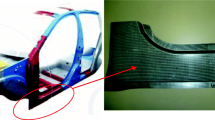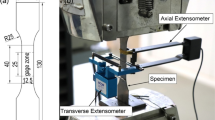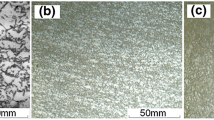Abstract
Automakers continuously develop new steel grades with high performance for the automotive industry: For example, dual phase steel (DP) and transformation-induced plasticity steel (TRIP) are now widespread. The use of these grades improves the crashworthiness of automotive bodies and allows a significant weight reduction for cars. However, these materials raise new challenges for manufacturers, especially for springback prediction, which affects the manufacturing precision. In this study, the influence of material models and coefficients of friction on the springback prediction is investigated. The stamping of an industrial example of the B-Pillar is analyzed using three coefficients of friction (\(\mu\)=0.08, \(\mu\)=0.12, \(\mu\)=0.16), four constitutive models (Hockett-Sherby, Swift, SHS, and mixed), and three yield functions (Barlat 91, Hill 90 and Hill 48). All numerical simulations are realized using Pam-Stamp software and compared with measurements. Based on the obtained results, a classification of different parameters is presented.
















Similar content being viewed by others
Data availability
Forming of industrial parts realized at ArcelorMittal, Post-processing and analyze of results realized at the laboratory LGM
Code availability
Commercial code Pam-Stamp 2G.
Abbreviations
- DP:
-
Dual phase
- TRIP:
-
Transformation-induced plasticity
- TRIP800:
-
Cold rolled transformation induced plasticity steel
- HS:
-
Hockett-Sherby
- AHSS:
-
Advanced high strength steel
- SHS:
-
Swift-Hockett-Sherby
- FEA:
-
Finite element analyses
- TWIP:
-
Twinning-induced plasticity
- HSS:
-
High strength steels
- FE:
-
Finite element
- SB:
-
Springback
- SBmax :
-
Maximum value of springback
- SBmin:
-
Minimum value of springback
- ∆SBmax :
-
Maximum variation of displacement
- ∆SBmin :
-
Minimum variation of displacement
- CAD:
-
Computer aided design
- BHF:
-
Blank-holder force
- SPD:
-
Punch speed
- \(K\) :
-
Hardening coefficient
- \(n\) :
-
Strain hardening exponent
- \(X\) :
-
Kinematic hardening
- \(X_{sat}\) :
-
Saturation value of the norm |X|
- \(C_{x}\) :
-
Saturation rate of \(X\)
- \(R\) :
-
Isotropic hardening
- \(R_{0}\) :
-
Initial value of the yield stress
- \(R_{sat}\) :
-
Saturation value of \(R\)
- \(C_{r}\) :
-
Saturation rate of \(R\)
- \(f\) :
-
Quadratic yield criterion
- \(F,G,H,L,M,N\) :
-
Material constants
- \(r_{0} ,r_{45} ,r_{90}\) :
-
Lankford coefficients in three anisotropic directions 0°, 45° and 90°
- \(x,y,z\) :
-
Orthogonal axes of orthotropic
- \(m\) :
-
Material constant
- \(g\) :
-
Barlat 91 yield function
- \({\varvec{S}}\) :
-
Deviator stress tensor
- \(S_{1} ,S_{2} ,S_{3}\) :
-
Principal values of the isotropic plastic equivalent deviatory stress tensor \({\varvec{S}}\)
- \(a,b,c,d,e,f,g,h\) :
-
Coefficients determined from uniaxial and shear yield stresses in the directions of the symmetry axes
- \(Th_{ini} \, \) :
-
Initial sheet thickness
- \(\mu\) :
-
Friction coefficient
- \(\sigma\) :
-
Flow stress
- \(\varepsilon_{0}\) :
-
Pre-strain
- \(\overline{\varepsilon }^{p}\), \(\varepsilon\) :
-
Effective accumulated plastic strain
- \(\sigma_{sat}\) :
-
Saturation stress
- \(\sigma_{0}\) :
-
Initial yield stress
- \(\alpha\) :
-
Weight factor
- \(\sigma_{ij}\) :
-
Equivalent tensile stress
- \(\sigma_{xx} ,\sigma_{yy} ,\sigma_{zz} ,\sigma_{xy} ,\sigma_{yz} ,\sigma_{zx}\) :
-
Components of the Cauchy stress tensor
- \(\sigma_{yy}^{1} ,\sigma_{yy}^{b}\) :
-
Yield stress obtained from uniaxial and equi-biaxial tensions, respectively
- \(\alpha ,\beta ,\gamma\) :
-
Constant parameters of material determined from the uniaxial and biaxial tension tests
- \(\sigma_{11} ,\sigma_{22} ,\sigma_{33} ,\sigma_{12} ,\sigma_{23} ,\sigma_{13}\) :
-
Stress tensor components
References
Grueebler R, Hora P (2009) Temperature dependent friction modeling for sheet metal forming. Int J Mater Form 2:251–254. https://doi.org/10.1007/s12289-009-0548-z
Saitoa N, Fukahoria M, Hisanob D, Hamasakib H, Yoshid F (2017), Effects of temperature, forming speed and stress relaxation on springback. In: Warm forming of high strength steel sheet international conference on the technology of plasticity, ICTP 2017, 17-22 September, Cambridge, United Kingdom
Santos AD, Teixeira P (2008) Study on experimental benchmarks and simulation results in sheet metal forming. J Mater Process Technol 199:327–336. https://doi.org/10.1016/j.jmatprotec.2007.08.039
Keum YT, Wagoner RH, Lee JK (2004) Friction model for FEM simulation of sheet metal forming operations. AIP Conf Proc 712:989–994. https://doi.org/10.1063/1.1766656
Kim C, Lee JU, Barlat F, Lee MG (2014) Frictional behaviors of a mild steel and a TRIP780 steel under a wide range of contact stress and sliding speed. J Tribol 136:021606. https://doi.org/10.1115/1.4026346
Lin J, Hou Y, Min J (2020) Effect of constitutive model on springback prediction of MP980 and AA6022-T4. Int J Mater Form 13:1–13. https://doi.org/10.1007/s12289-018-01468-x
Badr OM, Rolfe B, Zhang P, Weiss M (2017) Applying a new constitutive model to analyse the springback behavior of titanium in bending and roll forming. Int J Mech Sci 128–129:389–400. https://doi.org/10.1016/j.ijmecsci.2017.05.025
Liu X, Cao J, Chaia X, Liua J, Zhaoc R, Kong N (2017) Investigation of forming parameters on springback for ultra high strength steel considering young’s modulus variation in cold roll forming. J Manuf Process 29:289–297. https://doi.org/10.1016/j.jmapro.2017.08.001
Julsri W, Suranuntchai S, Uthaisangsuk V (2018) Study of springback effect of AHS steels using a microstructure-based modelling. Int J Mech Sci 135:499–516. https://doi.org/10.1016/j.ijmecsci.2017.11.043
Ben-Elechi S, Naceur H, Knopf-Lenoir C, Batoz JL (2012) Approche inverse améliorée pour la minimisation du retour élastique de pièces embouties. Eur J Comput Mech 17:349–372. https://doi.org/10.3166/remn.17.349-372
Ben-Elechi S, Khelifa M, Bahloul R (2021) Sensitivity of friction coefficients, material constitutive laws and yield functions on the accuracy of springback prediction for an automotive part. Int J Mater Form 14:323–340. https://doi.org/10.1007/s12289-020-01608-2
Quadfasel A, Lohmar J, Hir G (2016), Investigation of springback of high manganese TWIP-steels using three-point-bending. In: 3rd International conference on high manganese steels, Chengdu. https://doi.org/10.1016/j.proeng.2017.10.1052
Lee JY, Barlat F, Lee MG (2015) Constitutive and friction modeling for accurate springback analysis of advanced high-strength steel sheets. Int J Plast 71:113–135. https://doi.org/10.1016/j.ijplas.2015.04.005
Zhang DJ, Cui ZS, Ruan XY, Li YQ (2007) An analytical model for predicting springback and side wall curl of sheet after U-bending. Comput Mater Sci 38:707–715. https://doi.org/10.1016/j.commatsci.2006.05.001
Laurent H, Grèze R, Manach PY, Thuillier S (2009) Influence of constitutive model in springback prediction using the split-ring test. Int J Mech Sci 51(3):233–245. https://doi.org/10.1016/j.ijmecsci.2008.12.010
Oliveira MC, Alves JL, Chaparro BM, Menezes LF (2007) Study on the influence of work-hardening modeling in springback prediction. Int J Plast 23:516–543. https://doi.org/10.1016/j.ijplas.2006.07.003
Broggiato GB, Campana F, Cortese L (2008) The chaboche nonlinear kinematic hardening model: calibration methodology and validation. Meccanica 43:115–124. https://doi.org/10.1007/s11012-008-9115-9
Sumikawa S, Ishiwatari A, Hiramoto J, Urabe T (2016) Improvement of springback prediction accuracy using material model considering elastoplastic anisotropy and bauschinger effect. J Mater Process Technol 230:1–7. https://doi.org/10.1016/j.jmatprotec.2015.11.004
Komgrit L, Hamasaki H, Hino R, Yoshida F (2016) Elimination of springback of high-strength steel sheet by using additional bending with counter punch. J Mater Process Technol 229:199–206. https://doi.org/10.1016/j.jmatprotec.2015.08.029
Szakaly ED, Lenard JG (2010) The effect of process and material parameters on the coefficient of friction in the flat-die test. J Mat Process Tech 210:868–876
Barlat F, Lege DJ, Brem JC (1991) A six-component yield function for anisotropic materials. Int J Plast 7:693–712. https://doi.org/10.1016/0749-6419(91)90052-Z
Acknowledgements
The authors thank the company ArcelorMittal for the measurements and for the funding of a part of this research.
Funding
ArcelorMittal Maizières Research
Author information
Authors and Affiliations
Corresponding author
Ethics declarations
Conflict of interest
The authors declare that they have no conflict of interest.
Additional information
Technical Editor: Lincoln Cardoso Brandao.
Publisher's Note
Springer Nature remains neutral with regard to jurisdictional claims in published maps and institutional affiliations.
Rights and permissions
Springer Nature or its licensor holds exclusive rights to this article under a publishing agreement with the author(s) or other rightsholder(s); author self-archiving of the accepted manuscript version of this article is solely governed by the terms of such publishing agreement and applicable law.
About this article
Cite this article
Ben-Elechi, S., Bahloul, R. & Chatti, S. Investigation on the effect of friction and material behavior models on the springback simulation precision: application to automotive part B-Pillar and material TRIP800 steel. J Braz. Soc. Mech. Sci. Eng. 44, 380 (2022). https://doi.org/10.1007/s40430-022-03670-0
Received:
Accepted:
Published:
DOI: https://doi.org/10.1007/s40430-022-03670-0




